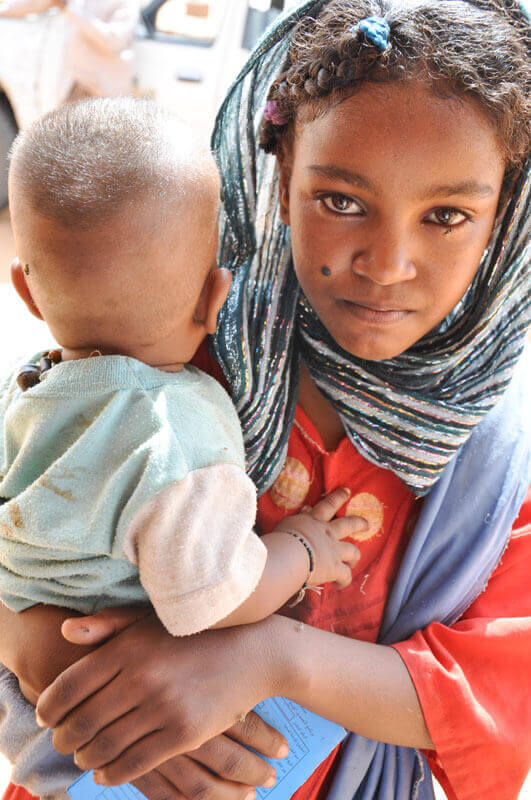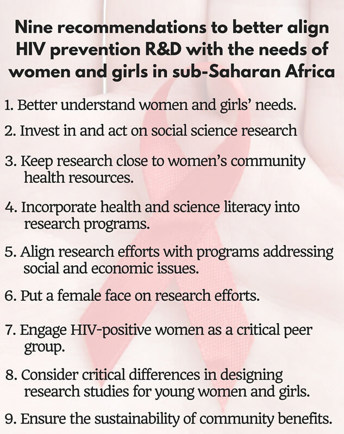Tom HarmonInternational AIDS Vaccine Initiative
Tom Harmon is a Senior Policy Analyst at the International AIDS Vaccine Initiative, a nonprofit working to develop preventative AIDS vaccines that are safe, effective, and accessible to all people.
In this guest post Tom Harmon, senior policy analyst at the International AIDS Vaccine Initiative (IAVI), and Anna Forbes, a globally recognized advocate for women’s HIV prevention needs, discuss a new piece proposing how HIV prevention research and development (R&D) for women and girls can better align with programs to improve their health and well-being.

Around the time a girl in sub-Saharan Africa reaches the age of fifteen her risk of HIV infection skyrockets from two to five times that of boys her age. This high incidence stands in contrast to the increasing success of the global HIV and AIDS response, which has seen global infections reduced year after year and millions more people living with HIV and AIDS able to access lifesaving antiretroviral treatment (ART).
It’s not news that HIV and AIDS has increasingly impacted young women and girls in sub-Saharan Africa. Fortunately, this past year may be remembered as a year the world stepped up to the challenge. The 2015 launch of the US$500 billion dollar DREAMS program (Determined, Resilient, Empowered, AIDS-free, Mentored, and Safe women) by the US President’s Emergency Plan for AIDS Relief (PEPFAR), the Bill & Melinda Gates Foundation, and Girl Effect aims to leverage high-impact interventions to reduce new HIV infections by 40 percent in girls and women in ten countries in Africa by 2017. Even as this program was scaling up, the World Health Organization expanded HIV treatment guidelines to cover all individuals living with HIV and AIDS regardless of the extent to which the virus has impacted their immune system status. This expansion will include many women and girls not previously covered.
These near-term efforts should make a substantial difference in women’s lives. It’s also encouraging that pre-exposure prophylaxis (PrEP)—just a few years after formal approval as an HIV prevention tool—is incorporated in DREAMS. We know that the optimal HIV prevention toolbox for women and girls is one that can be customized to meet each person’s individual needs. Continuing to expand that toolbox with other new HIV prevention options, including HIV-blocking microbicides and a preventive HIV vaccine, can ultimately break the back of the rising epidemic among women and girls and the global epidemic in the long-term.
 Research to develop and deliver effective new prevention options doesn’t take place in a vacuum—it must take into consideration the wider needs
of the women and girls it seeks to ultimately protect. To that end, IAVI recently published a new policy brief “Research and Development of New Biomedical HIV Prevention Tools for Women and Girls: Combating the global AIDS epidemic through a more empowered response in sub-Saharan Africa”
that summarizes findings and recommendations for improved HIV prevention research with and for women and girls.
Research to develop and deliver effective new prevention options doesn’t take place in a vacuum—it must take into consideration the wider needs
of the women and girls it seeks to ultimately protect. To that end, IAVI recently published a new policy brief “Research and Development of New Biomedical HIV Prevention Tools for Women and Girls: Combating the global AIDS epidemic through a more empowered response in sub-Saharan Africa”
that summarizes findings and recommendations for improved HIV prevention research with and for women and girls.
Our work highlights challenges to better align HIV prevention research for women and girls with the needs and realities of their lives. For instance, a recent issue of the Journal of Acquired Immune Deficiency Syndromes highlighted the relatively low participation of women in HIV vaccine trials (38 percent) and AIDS treatment trials (19 percent), which limits our understanding of how effective an intervention is for women and girls. And, we know that if research taking place in a community doesn’t ensure some ongoing community benefit once a trial is completed, it can discourage participation by women in future trials.
Fortunately, some of these essential elements are already being addressed. Positive results in microbicides research have correlated to excellent efforts to incorporate end user perspectives in product profiles. The Ragon Institute’s FRESH study links girls and young women highly vulnerable to HIV with programs that build job skills, attacking one of the drivers of poverty while also identifying early HIV infection and quickly enrolling women living with HIV and AIDS in ART programs.
Keeping HIV prevention R&D in touch with the renewed focus on fighting HIV and AIDS among women and girls in sub-Saharan Africa is critical to the long-term goal of ending AIDS. We’re proud to be part of an HIV prevention research community that is already making strides to improve the lives of women and girls while building the scientific knowledge necessary to bring new tools to the fight. Doing right BY communities will ensure that the fruits of our work will be more effective IN those communities.
Pockets of high incidence are devastating in any population and put overall progress at risk. Infectious diseases spread in the wider world when they are not stopped where they hit the hardest. This further underscores the importance of a sustained commitment to improving and expanding programs that reduce HIV incidence in women and girls and adding new interventions that women and girls can use to protect themselves.
None of this is possible if we can’t assure women and girls with a strong HIV response that engages them, listens to them, and then implements the programs and research necessary to make this feminized epidemic yesterday’s news.